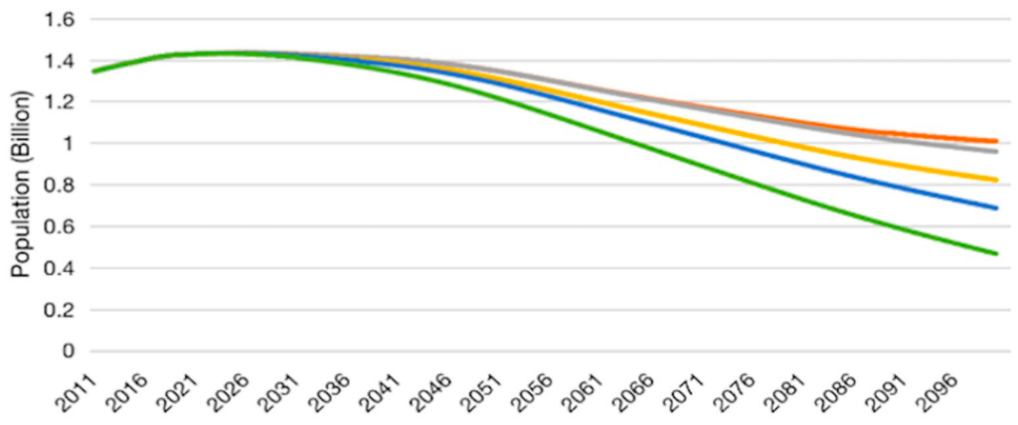Population dynamics profoundly shape societal development and economic growth. The size and composition, through the population consumption and production trends, are correlated with multiple societal issues. As cities are the fundamental units for decision-making processes, city-level population data is vital for policy makers in areas of urban planning, shrinking cities, GHG emission projection, GDP projection, disaster risk mitigation, public health risk assessment, etc. Considering increasing research emphasizes the necessity of high-resolution population forecasts for effective risk management and comprehensive urban planning, developing city-level population projections for China has extensive practical value and application prospect.
Against this background, Cai Wenjia’s Research Group of the Department of Earth System Science (DESS) and Wang Can’s Research Group of the School of Environment, Tsinghua University release city-level population projections for China under different socio-economic pathways, and the research results were published online in Scientific Data of Nature Research in a form of a paper titled “City-level population projection for China under different pathways from 2010 to 2100”.
The model scenarios have been redesigned and optimized based on the population migration and fertility characteristics reflected in the Seventh National Census to address the problems of grid-level projections, namely, substantial errors at the city level, impact of new birth and household registration policy and the poor applicability of Shared Socioeconomic Pathways (SSPs) in China.
The model structure has been improved in the study to include detailed population data such as city-level age structure and gender structure, making it possible to estimate the parameters more accurately at the city level. The migration module of the model has been redesigned to take the latest migration policy into account in the projections, and the appeal to different levels of population between regions and the different appeal of cities in the same region to population have been accurately delineated. Finally, according to the characteristics of population migration and fertility reflected in the Seventh National Census, the model scenarios have been redesigned and optimized, providing researchers with a variety of fertility and migration scenarios from 2010 to 2100. This improvement has addressed the applicability of SSP scenarios (especially unequal SSP4 and fossil fuel-dominated SSP5) under the goal of overall poverty alleviation, common prosperity, compulsory education and carbon peaking and carbon neutrality in China.
The results show that after considering the more realistic hypothesis of future fertility rate, a huge gap will be found in the total population projections of China under different fertility scenarios by 2100. The extremely high fertility scenario can be maintained at 1.02 billion people, while the total population under the low fertility scenario will drop to 470 million people. The results show that China will face an aging problem far beyond expectations in the future. Under the scenario of low fertility rate, China's aging rate (the proportion of people aged 65 and over to the total population) will rise from 13.5% in 2020 to 58.4% in 2100, while according to the projection of the United Nations, the global aging rate will only increase from 9.4% in 2020 to 24.0% in 2100.
The research has made important improvements on the basis of the previous research results published in 2020, "China's provincial and grid population forecast in 2010-2100 under the shared socio-economic path". The new results present significant value in the following specific application scenarios: 1. Researchers have higher requirements for the accuracy of urban population; 2. Researchers hope to adopt the scenario closest to the development of China, and select the appropriate fertility and migration assumptions according to their own assumptions and needs; 3. If researchers need gridded data, they can get the relative population distribution between each grid from the data of previous research results, and downscale the city-level population data from this study.
For a more detailed introduction to the use of the data in this study, please refer to the full-text link at the end of the article. The data herein (including the population forecast data of China at city, provincial and national levels by gender and age under different socio-economic paths from 2010 to 2100) can be used for non-commercial research. See the links at the end of the article for free downloading of the article and free data downloading.

Figure Future population changes at the national level from 2011 to 2100 under five fertility scenarios (data about the population distribution results under the combination of different fertility rate and migration can be retrieved by downloading)
Zhang Shangchen, a 2022 doctoral student from the DESS, Tsinghua University, is the first author of the paper, and Professor Cai Wenjia from the Dess, Tsinghua University, is the corresponding author of the paper. Cai Wenjia’s Research Group of the DESS and Wang Can’s Research Group of the College of Environment, Tsinghua University have long been committed to climate change economics, energy, environment and economic system simulation, and environmental and health impact assessment of climate change mitigation. This work is jointly supported by National Natural Science Foundation of China (72091514) and China Meteorological Administration Climate Change Special Program (CMA-CCSP), among others.
Full-text link:
https://www.nature.com/articles/s41597-023-02735-6
Free data download (either one is OK):
1.https://doi.org/10.6084/m9.figshare.c.6669299.v1
2.https://cloud.tsinghua.edu.cn/f/d593f46793fb4145b8b9/?dl=1
Written by Zhang Shangchen and Cai Wenjia
Edited by Wang Jiayin
Reviewed by Zhang Qiang